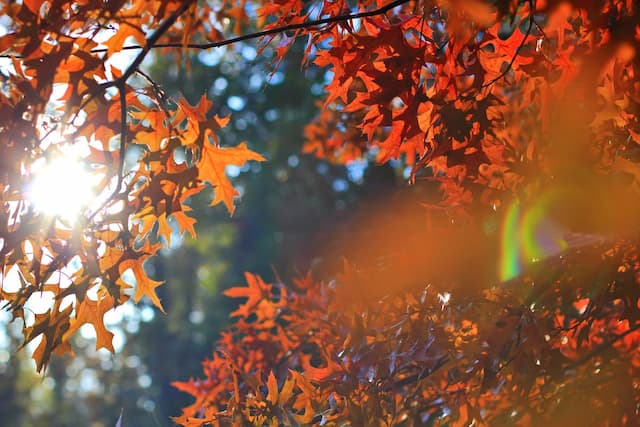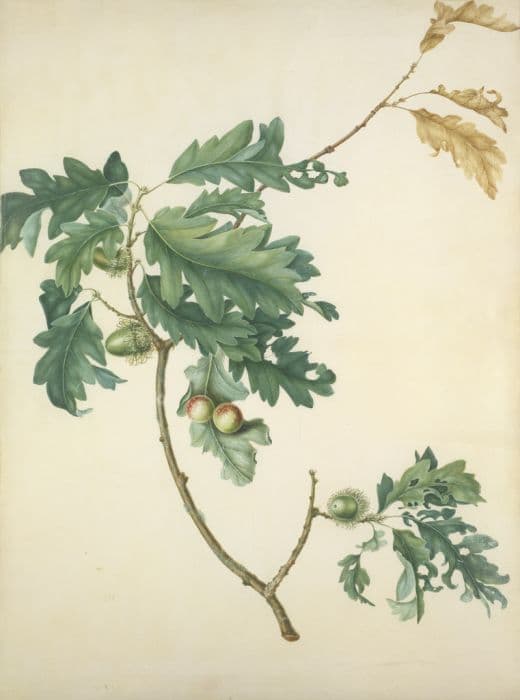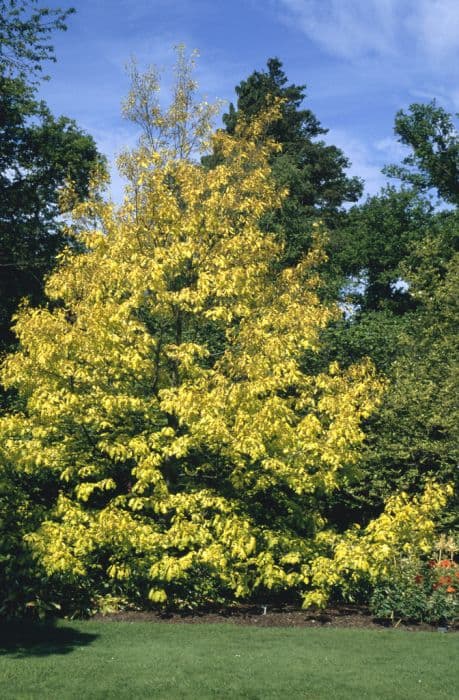Turner’s Oak Quercus × turneri 'Pseudoturneri'

ABOUT
The plant known as Turner's Oak is a hybrid variety that exhibits a spread of dark green, leathery leaves with a glossy texture. The foliage is distinct due to its lobed margins with a somewhat sinuous outline. During the fall, the leaves of Turner's Oak often turn to elegant shades of yellow or brown, providing a visually pleasing, autumnal display. The overall shape of Turner's Oak is rounded, with a symmetrical canopy that gives a full and lush appearance. The bark on the trunk and branches often feature a rugged texture, adding to its classic tree look. In spring, the plant may produce catkins, which are slim, cylindrical flower clusters that often droop downwards. These might not be particularly showy when compared to other flowering trees, but they do contribute to the tree's seasonal interest. Turner's Oak develops acorns as fruit. These nuts are oval or round in shape, encased in a tough shell with a slightly rough texture. The cap that holds the acorn is scaly and typically covers a portion of the nut.
About this plant
 Names
NamesFamily
Fagaceae
Synonyms
Turner's Oak, Turner Oak
Common names
Quercus × turneri 'Pseudoturneri'.
 Toxicity
ToxicityTo humans
The Quercus × turneri 'Pseudoturneri' is commonly known as the Turner's Oak. Oaks in general are not highly toxic to humans, but all parts of the plant, especially the acorns and leaves, contain tannins which can be harmful in large quantities. Ingesting significant amounts of these parts can potentially lead to stomach upset, nausea, vomiting, and diarrhea. However, it is quite rare for humans to consume enough of the plant material to cause severe poisoning.
To pets
The Turner's Oak is considered to be of mild to moderate toxicity to pets such as dogs and cats. Similar to their effect on humans, the acorns and leaves contain tannins that can cause gastrointestinal distress if ingested in large amounts. Symptoms of poisoning in pets might include vomiting, diarrhea, abdominal pain, and lack of appetite. In severe cases, ingestion of large quantities could lead to kidney damage or other serious complications, but such instances are uncommon. It is always advisable to monitor pets and prevent them from eating non-food plants.
 Characteristics
CharacteristicsLife cycle
Perennials
Foliage type
Semi-deciduous
Color of leaves
Green
Height
50 feet (15 meters)
Spread
35 feet (11 meters)
Plant type
Tree
Hardiness zones
5
Native area
Europe
Benefits
 General Benefits
General Benefits- Aesthetic Appeal: Enhances garden beauty with its attractive foliage and structure.
- Shade Provider: Large canopy offers shade, making it ideal for parks and large gardens.
- Habitat for Wildlife: Supports biodiversity by providing habitat and food for birds and insects.
- Soil Stabilization: Strong root systems reduce soil erosion and improve ground stability.
- Carbon Sequestration: Absorbs carbon dioxide, thus contributing to climate change mitigation.
- Longevity: Oaks are known for their long lifespan, providing benefits for generations.
- Drought Tolerance: Once established, it requires less water, suited for xeriscaping.
 Medical Properties
Medical PropertiesThis plant is not used for medical purposes.
 Air-purifying Qualities
Air-purifying QualitiesThis plant is not specifically known for air purifying qualities.
 Other Uses
Other Uses- The Turner oak's acorns can be used for crafting or as decorative elements, especially in autumnal displays or for educational purposes to showcase different seed types.
- The wood from Turner oak is valued for woodworking projects, particularly for furniture making, due to its unique grain patterns and durability.
- Dye can be extracted from the bark of Turner oak and used in textile dyeing, giving fabrics and yarns a range of brown hues.
- Turner oak leaves can be used in gardening as a natural mulch, providing nutrients to the soil as they decompose.
- The Turner oak can be planted as a part of a wildlife garden, offering habitat and food for birds and squirrels.
- Its large canopy provides excellent shade in landscapes and urban areas, reducing urban heat island effect.
- Turner oak wood can be used in smoking food to impart a unique flavor, especially in barbecuing meats.
- The strong timber is suitable for construction purposes, including beams and other structural elements that require strength and resilience.
- In landscape design, the Turner oak can be used as a hedging plant when grown closely with others of its kind.
- Its distinctive leaf shape and branching can be used for art projects, such as leaf printing or natural stencils.
Interesting Facts
 Feng Shui
Feng ShuiThe Oak is not commonly used in Feng Shui practice.
 Zodiac Sign Compitability
Zodiac Sign CompitabilityThe Oak is not used in astrology practice.
 Plant Symbolism
Plant Symbolism- Strength: The common name for Quercus × turneri 'Pseudoturneri' is Turner's Oak, and oaks in general symbolize strength due to their hard, solid wood and their long-lasting nature.
- Endurance: Turner's Oak is a representation of endurance owing to an oak's ability to live for many years and endure harsh weather conditions.
- Wisdom: Oaks are often associated with wisdom, as they grow slowly and seem to represent the knowledge and experience gained over a vast period of time.
- Nobility: Due to their impressive stature and long life, oaks can be symbolic of nobility, emulating the grandeur and dignity of noble classes in history.
- Stability: The strong root system of Turner's Oak reflects stability and grounding, forming a symbol for a firm foundation in both physical and metaphorical senses.
- Heritage: Turner's Oak can symbolize heritage and ancestry, as oak trees are often found in old growth forests and can be ancestral markers in landscapes.
 Water
WaterThe Turner Oak, or Quercus × turneri 'Pseudoturneri', requires moderate watering. During the growing season, water the plant deeply once a week, providing approximately 1-2 gallons of water per event to ensure the soil is moist but not waterlogged. Reduce watering in the winter months, allowing the top inch of soil to dry out between watering sessions. It's important not to overwater, as this can lead to root rot. Always check the moisture level at the root zone before adding water to prevent over-saturation.
 Light
LightThe Turner Oak thrives in full sun to partial shade. It prefers a location where it can receive at least 6 hours of direct sunlight per day. While it can tolerate some light shade, especially during the hottest parts of the day, optimal growth and health are achieved in a brighter environment with plenty of sunshine.
 Temperature
TemperatureThe Turner Oak is hardy and can tolerate a wide range of temperatures, but it does best in climates where the temperature ranges between 50°F and 80°F. It can survive brief periods of colder winter temperatures down to 20°F and summer highs up to 90°F or slightly higher, but prolonged exposure to extremes can stress the plant. Ideally, keep it in a location where the temperature remains within the favorable range.
 Pruning
PruningPrune the Turner Oak to maintain its shape and remove any dead, damaged, or diseased branches. The best time for pruning is late winter or early spring, before the onset of new growth. Typically, once a year is sufficient, but it may be pruned more often if necessary, such as to remove broken limbs after a storm. Make clean cuts and avoid leaving stubs to allow the tree to heal properly and to maintain its health and aesthetics.
 Cleaning
CleaningAs needed
 Soil
SoilThe Turner Oak (Quercus × turneri 'Pseudoturneri') thrives in well-draining soil composed of loamy or sandy-clay soil with organic matter. A pH between 6.0 and 7.5 is ideal. To create the best soil mix, combine garden soil, compost, and coarse sand to ensure proper drainage and fertility.
 Repotting
RepottingThe Turner Oak typically does not need frequent repotting due to its growth habit. It is often planted in a permanent location outdoors. If planted in containers, repotting can be done every 3-5 years or as the plant outgrows its pot, using the aforementioned soil mix.
 Humidity & Misting
Humidity & MistingThe Turner Oak is able to adapt to a wide range of humidity levels typical of outdoor environments. Ideally, this oak prefers average outdoor humidity levels without the need for additional humidity control measures.
 Suitable locations
Suitable locationsIndoor
Ensure bright light, correct pot size, infrequent watering.
Outdoor
Plant in well-draining soil, full sun or partial shade.
Hardiness zone
5-8 USDA.
 Life cycle
Life cycleThe life cycle of Quercus × turneri 'Pseudoturneri', commonly known as Turner's Oak, begins with the acorn, its reproductive seed. These seeds undergo germination when conditions are appropriate, generally in spring, requiring adequate soil, water, and sunlight. The seedling emerges and progresses into a sapling, characterized by rapid growth and the development of a sturdy root system. As it matures into an adult tree, Turner's Oak develops a broad canopy and may produce acorns, typically after 20-30 years. In its adult phase, the tree can live for several centuries, with some specimens reaching over 500 years of age. Throughout its life, the tree undergoes seasonal changes, with leaves turning color and falling in autumn, followed by a period of dormancy in winter.
 Propogation
PropogationPropogation time
Spring-Early Summer
The most popular method of propagation for the Turner Oak, a hybrid name for Quercus × turneri 'Pseudoturneri', is through the collection and sowing of acorns, due to its hybrid nature which might not come true from seed. This is typically done in autumn, right after the acorns have fallen to the ground. The collected acorns need to be sown immediately as they do not store well and their viability quickly decreases with time. They should be planted in a mix of soil and sand at a depth of approximately 1 to 2 inches (2.5 to 5 cm), in a well-draining container. It is crucial to keep the soil moist but not waterlogged, and the container should be placed in a cool, bright area until germination, which may take several weeks to a few months. Once the saplings are strong enough, they can be transplanted into larger pots or directly into the ground in their permanent location.




